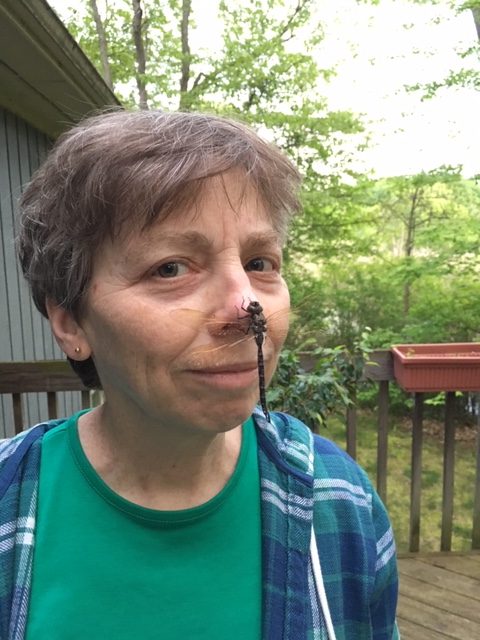
GUEST BLOGGER BUFFY SILVERMAN
As summer ends, plants and animals prepare for a season of change. Squirrels and chipmunks gather nuts and seeds, storing them underground. Animals that will hibernate eat and eat, growing layers of fat. Insects and spiders lay eggs that will hatch in spring. Migrating birds gather before flying to places where food is more abundant. Sticky seeds cling to animal fur and pants legs. Leaves begin to change color.
On a Gold-Blooming Day: Finding Fall Treasures celebrates these seasonal changes. Your students can observe these seasonal changes and use their observations to inspire their writing.
Make a fall word list
Show your students the cover of On a Gold-Blooming Day. What season is depicted on the cover? When you are outdoors in the fall, what might you see? What might they hear, smell, taste, and touch? What words would they use to describe that season? Make a list of fall words that include your students’ responses.
Read the main text of the book once to your class. Then read it again and ask students to remember a favorite word from the book. Add those words to your list.
Show the students the back matter of the book. In the back matter they can find more information about the plants and animals depicted in the photographs. Notice that each word pair (for example: Sumacs blaze) has an entry. Read the paragraph about sumacs from the back matter. Tell them that during fall, after leaves turn color, they fall from deciduous trees. In the activities below, students will gather some of these fallen leaves and use them for a sorting activity.
Activity 1: Gather leaves
Take your students outside for a fall hike. You can walk around your school yard, around the block, or at a local park. Bring along bags to collect fallen leaves. Ask each child to find leaves from several different trees, vines, or bushes, and put their leaves in their bags. Encourage students to make other observations about the changes they see occurring around them.
Activity 2: Sorting leaves
Scientists often observe how living things are alike and how they are different. By observing closely, students can think like a scientist. They can also use their observations to enhance their writing.
Working alone or in pairs, let students sort the leaves they collected in a way that makes sense to them. For example, students might arrange leaves by size, shape, or color. After the leaves have been sorted, let each child or pair guess how another pair sorted their leaves. Then challenge them to find a different way to sort the leaves.
Activity 3: Gather more words
Ask your students to choose words that describe the leaves they sorted. Add them to the list of fall words. You might challenge your students to combine words on the class list to invent new descriptions like those in On a Gold-Blooming Day (for example, gold-blooming and bee-zooming.)
Activity 4: Be a tree and tell your story
Challenge your students to write a poem or paragraph from the point-of-view of a tree in autumn. What changes are happening to them as a tree? Are there any animals climbing on them or trotting beneath them? What are these animals doing? How does it feel to be a tree before winter arrives? If students need a prompt they could begin with:
I am Maple.
My leaves…
My branches…
I feel…
I hear…
I see…
Encourage them to include words from the class list of fall words. Let them illustrate and name their tree.



Activity 5: Read about trees
Once your students have written their tree tale, they might enjoy hearing how other authors have written about trees. You might wish to share these books or other tree stories with your class:
- Be a Tree! Gianferrari, Maria and Felicita Sala. Abrams, 2021.
- Because of an Acorn. Schaefer, Lola and Adam Schaefer and Frann Preston-Gannon. Chronicle Books, 2016.
- Can You Hear the Trees Talking? Wohlleben, Peter. Greystone Kids, 2019.
- A Leaf Can Be… Salas, Laura Purdie and Violeta Dabija. Millbrook Press, 2012.
- The Leaf Detective. Lang, Heather and Christy Jana. Calkins Creek, 2021.
Featured image credit: “Falling with grace” by Memotions is licensed under CC BY 2.0.
Buffy Silverman is the author of over 90 nonfiction books for children, featuring topics from Angel Sharks to Alligators, and Mars to Monster Trucks. Her recent book, On a Snow-Melting Day: Seeking Signs of Spring, received a star from Kirkus Reviews and was an NCTE 2021 Notable Poetry Book. A companion book, On a Gold-Blooming Day: Finding Fall Treasures was published by Millbrook Press in fall, 2022. Buffy spent many years as a naturalist and environmental educator, and taught biology to college students. Now she enjoys speaking to students about nonfiction, poetry, and writing. She lives near a swampy lake in Michigan where she watches and photographs nature and writes about the creatures she observes.
Website: www.buffysilverman.com
Twitter: @buffysilverman










Leave a Reply
Your email is safe with me.